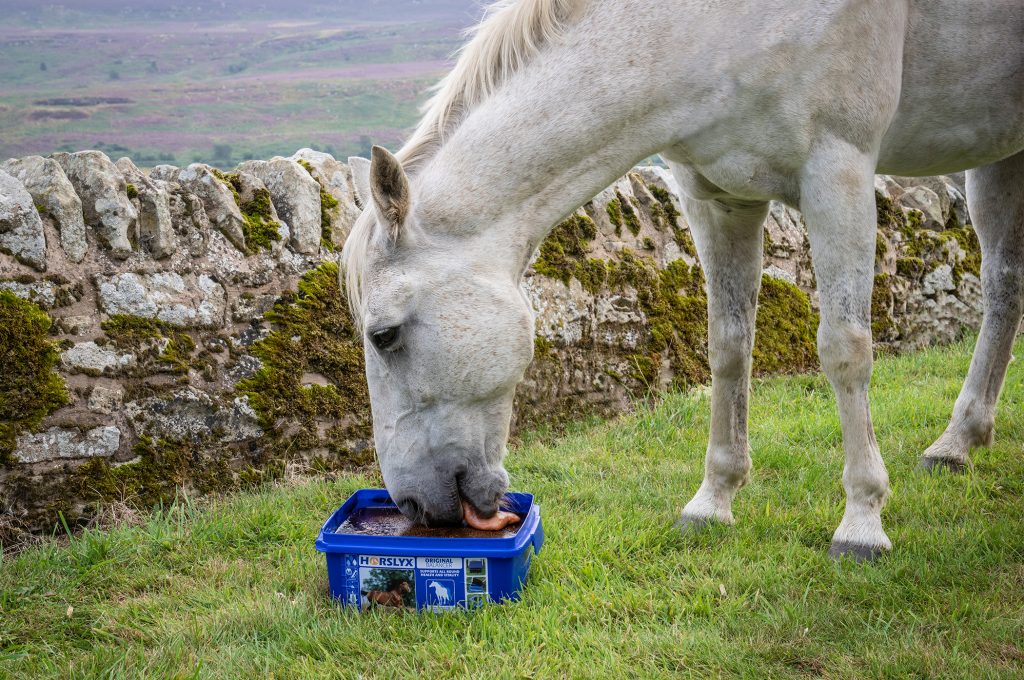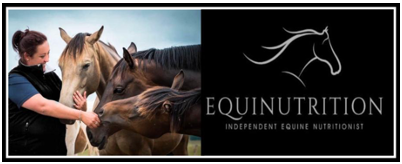“As Dr Green is growing well all over the country, we at Horslyx spoke with Jennifer Little Bsc Hons MSc RNutr at Equinutrition for her thoughts on the contributions and the limitations of grass in our horses diets.
For the majority of leisure horses in the UK, grass makes up the significant source of the fibre or forage within their diets. Frequently I hear first hand from owners regarding concerns relating to the percentages of certain nutrients in hard feeds, bagged fibres and supplements, when in reality these are usually fed in small amounts of 30g-2kg per day, for a typical 500kg horse, in comparison to the 15kg or more of grass consumed if turned out for 24hrs. Often insufficient consideration is afforded to the contribution of grass to the overall diet unless there’s the scenario of insufficient amounts of grass to maintain body condition, or scenarios where high grass levels are causing excessive weight gains and increased risk of dangerous conditions such as laminitis.
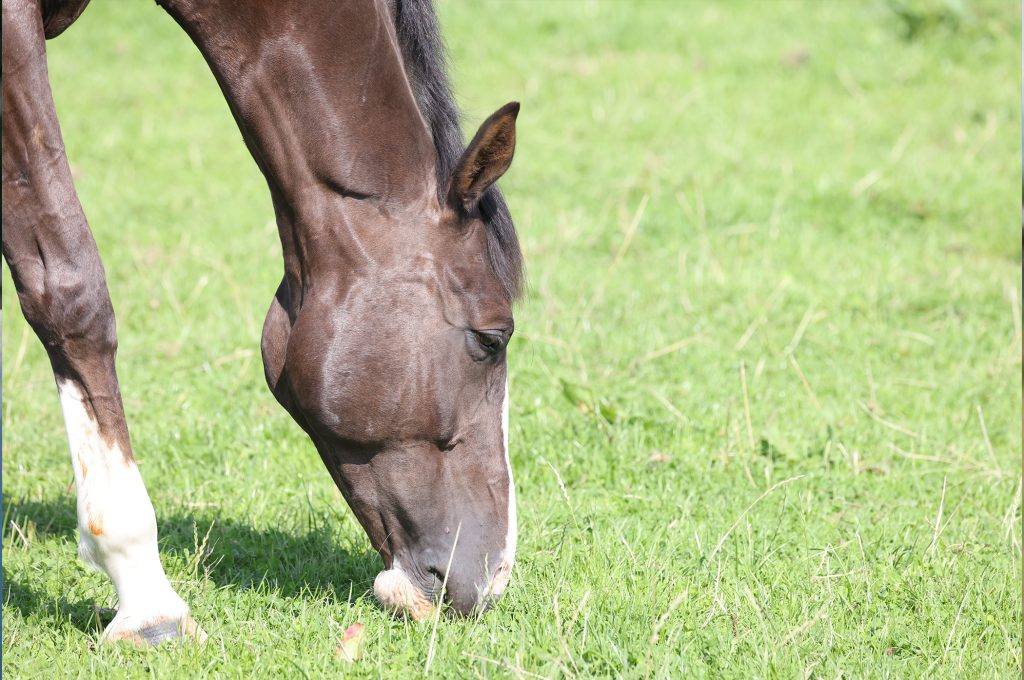
As an independent equine nutritionist, the access to, and the type of grazing available, is the foundation for calculating an appropriate ration for each individual horse, especially as grass forms the majority of many horses’ diets and because it is such an inconsistent source of nutrients. The amount of grass available, and the nutrients contained within it, are affected by the nutrient density within the soil, the management of the grazing, temperatures and rainfall and the time of the year. The individual horse’s body condition, any pre-existing conditions and workload can influence the suitability of one type of grazing over another. In this article I will discuss two common scenarios relating to grazing, and the imbalances to a horse’s ration that grass imposes. Imbalances can present as both deficiencies and as excesses in the provision of nutrients.
When grass is too much and too little – all at the same time
Unfortunately, with over half the UK population of horses and ponies being overweight or obese the availability of grass more commonly concerns the provision of energy (calories) in excess to a good-doer’s requirements. Figure 1 demonstrates the provision of key nutrients from a diet consisting entirely of ‘good available spring grass’, with no hard feed or supplementation, in comparison to the nutrient requirements for a 500kg horse in light work, and ideal body condition. This graph illustrates how grass can result in both excesses and deficiencies in certain nutrients, simultaneously.
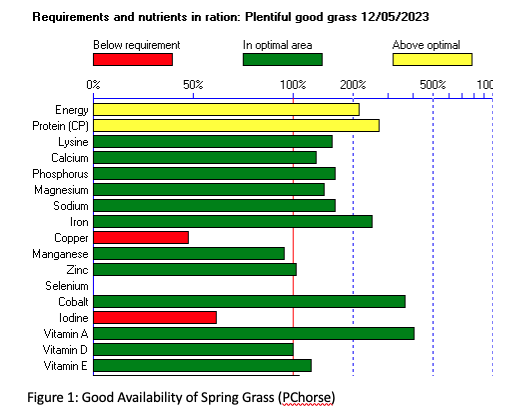
Across the top of the graph is the % of the nutrients provided compared with the horse’s requirements, with 100% representing their total requirement. The key nutrients are listed along the left-hand side, with total % compared with the requirement listed on the right-hand side. The bars shown in green demonstrate that the level of provided nutrient sits in the optimal range, and is neither below, nor in excess, to imbalance the diet. Whereas the yellow bars demonstrate a significant excessive contribution and the red or absent bars demonstrate a significant deficiency.
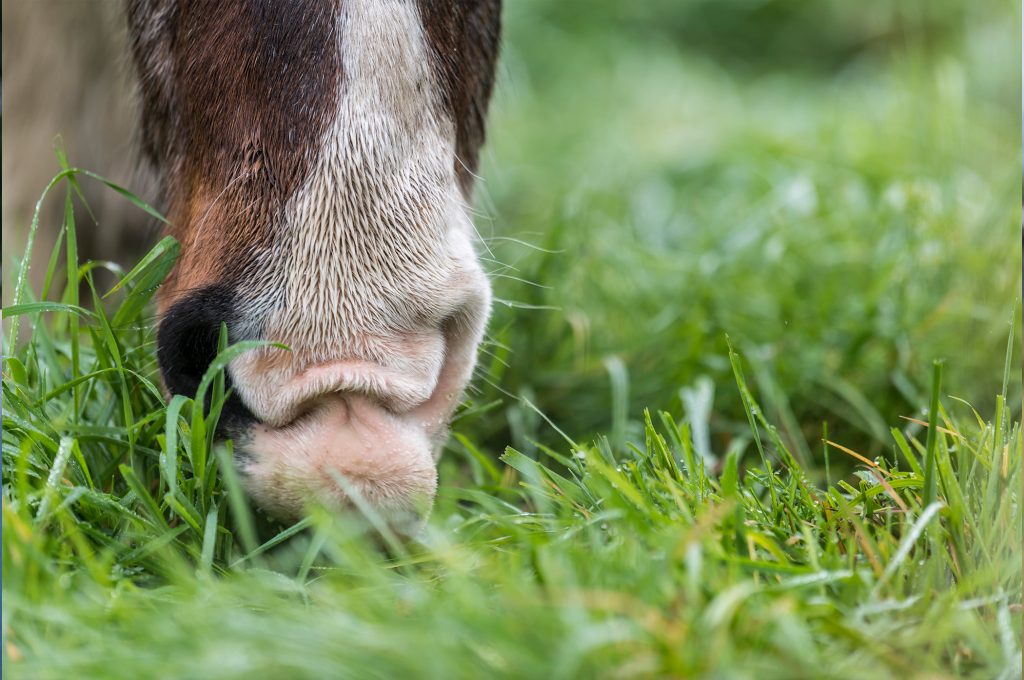
In this scenario a diet consisting of just plentiful good spring grass provides excessive total energy, or calories and excessive protein levels. This would likely cause weight gain, that while desirable for some, is likely to be undesirable for many. For those already overweight, those prone to excessive weight gain and for those sensitive to sugar intake, this could be problematic and even potentially dangerous. In order to control these excesses, a number of measures can be employed. Increasing the horse’s workload and work intensity would increase its total energy and protein requirements, possibly compensating for the surplus from the good grass.
If it’s not possible to significantly increase the horse’s workload, measures to reduce the amount of grass consumed would be required. These measures can include strip grazing to reduce the area of grass available or moving the horse to a field with poorer grass. By utilising grazing muzzles, the total amount of grass consumed while turned out can be decreased.
It may be required to reduce the duration of grazing per day, bringing a horse in and off the grass for several hours per day, to reduce the total grass consumed. Care should be taken to prevent periods of 4 hours plus without anything to chew, rather grass can be switched to a low-calorie fibre alternative such as a poorer hay or haylage, a proportion of straw can be included or even lower energy content fibre replacing chaff. The rate of intake should be controlled or slowed down, via the use of suitable small-holed nets or forage balls to ensure periods of 4 hours plus with no forage is prevented.
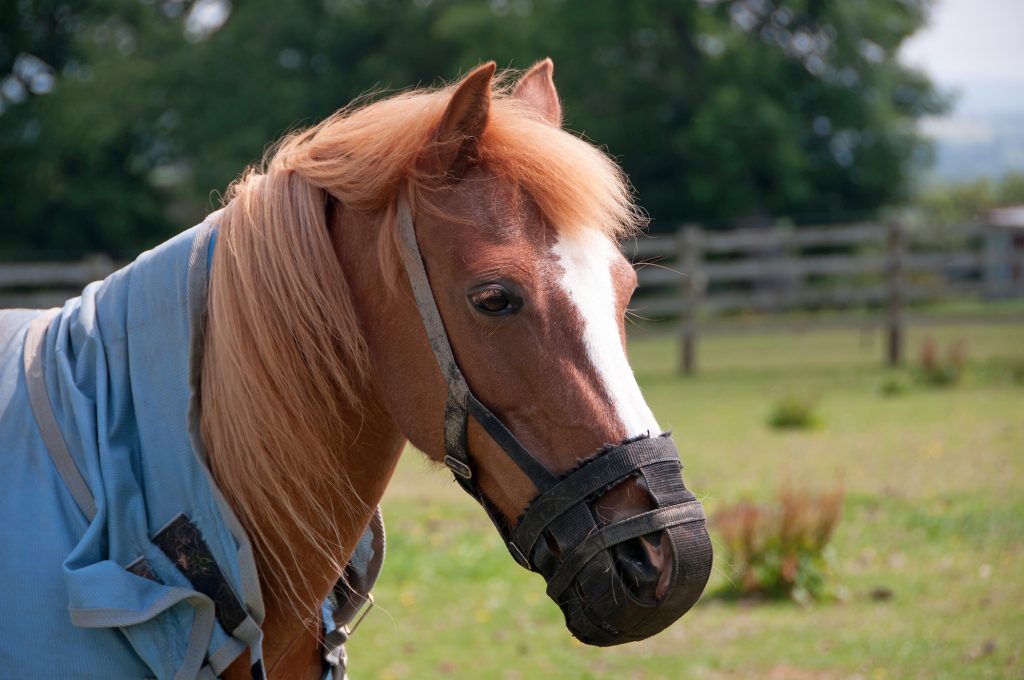
While these measures would help to address the excessive energy (calorie) and protein intake, they won’t address the vitamin and mineral deficiencies also present. In the case of poor doers needing to gain weight, correcting this imbalance is relatively simpler. The addition of a fortified suitable compound feed, usually fed at 2-5kg per day for such a 500kg horse will supply additional calories and the required vitamins and minerals absent or deficient from a diet of grass alone. However, for the good-doer this approach is unsuitable as while providing the vitamins and minerals, it would also provide calories in excess. These horses will require a suitable vitamin and mineral supplement formulated for low intake.
When grass is too little
Not every horse has the privilege or ‘curse’ of surplus grazing. Several factors can limit the amount and quality of grass available. Including, over stocking of horse numbers, poor soil quality, limited allowed turn out duration, un-rested fields, rainfall levels, and temperatures. Figure two illustrates the impact of poor grazing for a typical 500kg horse’s ration.
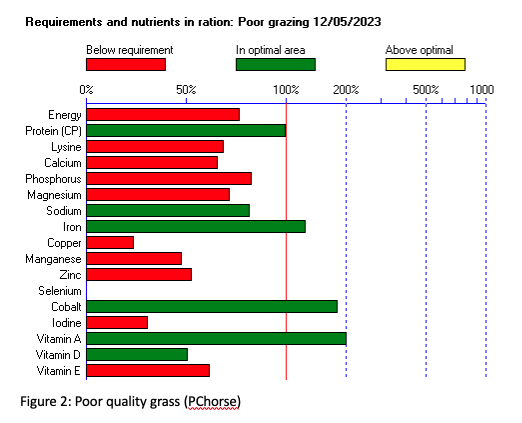
In this scenario a diet consisting of just poor grass is still sufficient in total protein and some other key nutrients, but it is insufficient for total energy (calories). It is also responsible for the increase in the deficiencies of certain vitamins and minerals.
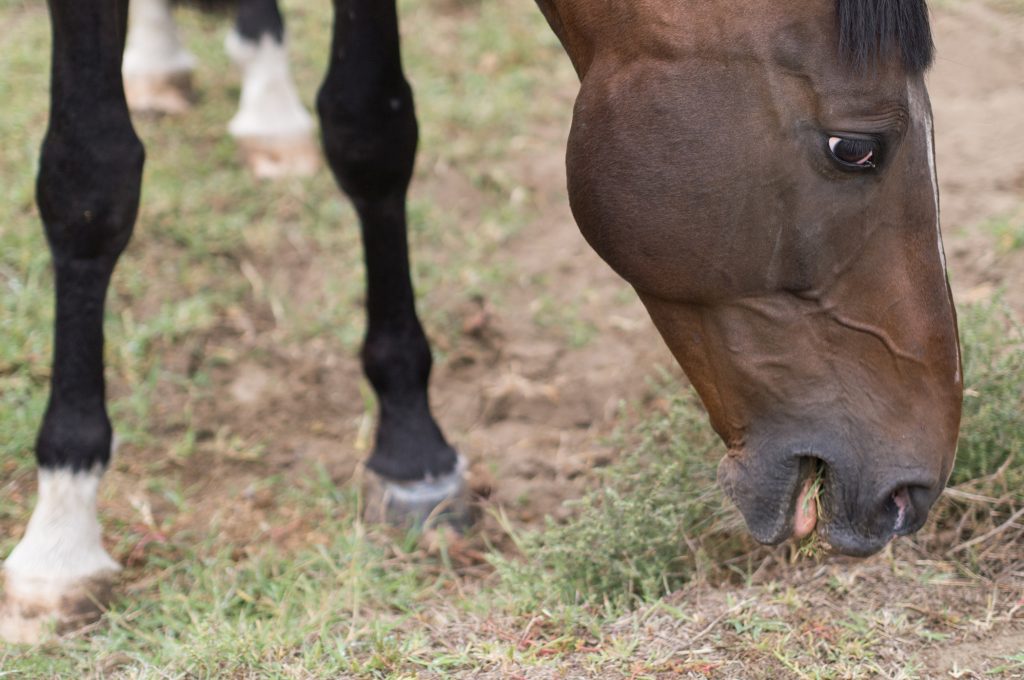
This would likely result in weight loss. While weight loss maybe desirable for some horses, the provision of additional forages such as hay or low energy forage replacers is possibly required to ensure sufficient fibre intake (1.5-2% bodyweight/day based on dry matter). For the poor doer again a suitable concentrate feed would provide the required additional calories and ensure sufficient vitamins and minerals. For the overweight or good-doer the supply of the required additional vitamins and minerals needs to be in a low intake feeding rate, so as to prevent excessive energy intake.
Suitable forage and balancing the required vitamins and minerals
When the provision of grass and potentially additional sources of forage are correct to maintain an appropriate body condition and weight, the forages inability to provide sufficient levels of key vitamins and minerals still persists. Horses are great compensators for such deficiencies, but as owners we should be responsible for ensuring they don’t need to. Figure 3 illustrates how the addition of a suitable vitamin and minerals supplement to a horse’s diet, when the forage is correct for fibre and energy levels can produce a ration within the optimal range of all the key nutrients.
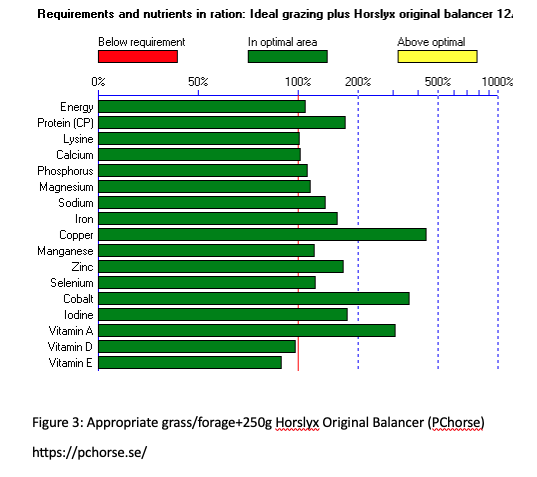
Grass alone has the potential to provide both insufficient or excessive energy (calories) to maintain a healthy body condition. Even when the grass levels and type are sufficient to provide optimal fibre and energy, it is unlikely to provide a sufficient supply of the key vitamins and minerals.
In situations where it’s unsuitable to provide these with conventional hard feeds, the provision of vitamins and minerals in the form of a balancer, or a vitamin and mineral supplement is advisable. As figure 3 illustrates the use of vitamin and mineral block such as Horslyx Original Balancer, which is ideal for field feeding, can achieve an optimal ration. The advantage of such a field block is undoubtedly the convenience of such a method to provide a constant supply these vitamins and minerals, allowing an owner to focus on grass quantity, quality and their horse’s body condition.
